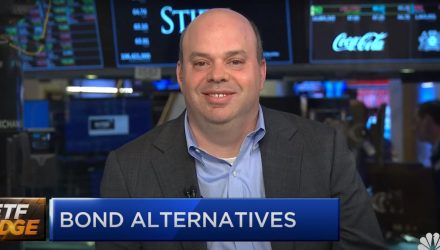During Exchange, the recent conference, many wondered what to do with client bond funds in the face of rapidly rising rates. On this week’s ETF Edge, host Bob Pisani spoke with ETF Trends’ director of research, Todd Rosenbluth, and John Maier, CIO for Global X ETFs, to discuss this topic of bond alternatives and more.
Maier claims bonds can be, at least, partially replaced with Global X’s income equity portfolios. As Maier explains, aspects such as covered calls, the preferreds sectors, master limited partnerships (MLPs), and the nature of high dividend/low volatility all add to why this would cater to the equity income side compared to the fixed-income side.
For Rosenbluth, when asked about whether or not investors are buying into these odd corners of the market, he notes how this is very much the case. “We’re seeing the demand for covered call-related ETFs, like JEPI and QYLD,” Rosenbluth adds. He’s also seeing popularity for dividend-oriented ETFs, showing plenty of investor interest.
Getting back to what works about high dividend/low volatility, Maier explains how some portfolios are restrained and that many investors simply need that yield. And the yield is coming from quality dividends that have profitable growth and quality value, let alone are less sensitive to economic growth.
Maier goes on to specifically point out the Vanguard High Dividend Yield ETF (VYM) and the iShares Core Dividend Growth ETF (DRGO). With the Global X portfolios, it’s using funds like these that will only add to maintaining strong cashflows.
The Other Alternatives
When looking at MLPs, Rosenbluth points out how they are different from traditional energy companies, as they are often not found within the broader S&P 500. For the sake of equity income investing, MLPs bring exposure to more companies, allowing for a rise in oil/gas-related benefits, as well as high yields. Additionally, they must distribute 90% of income as dividends. Noted as an example, the Alerian MLP ETF (AMLP) matches what’s noted as the qualifiers to give weight to this bond alternative.
Maier makes one more statement, explaining that “MLPs are highly correlated to the movement in interest rates. So, as interest rates go up, MLPs also potentially go up. they also have some correlation to the energy market.”
There’s also a discussion of real estate investment trusts (REITs), one of the better-performing sectors. As Rosenbluth explains, REITs provide equity exposure to dividend-paying companies. It’s a diversified route to take and has been proven to be much more growth-oriented than noted in the past. A good example that’s been working for investors here is the Vanguard Real Estate ETF (VNQ).
One more alternative noted earlier – covered calls. As Maier notes, funds like QYLD have an underlying component that’s the Nasdaq 100. For Global X, they sell the money index option and pass that income onto the shareholder. It’s essentially making a tradeoff. “You’re getting that income, and you’re trading your upside for that income,” Maier adds.
Rosenbluth adds that covered calls have been one of the more popular areas in the ETF space, let alone proof of the resilience of the ETF structure. It can be complicated to make this work outside of the ETF concept, but with a fund like QYLD or JEPI, or DIVO, these covered call-related ETFs get plenty of traction that payoff for the investor with little difficulty for those embracing it.
Hear More Thoughts from Todd Rosenbluth on the ETF Edge Podcast:
For more news, information, and strategy, visit the Thematic Investing Channel.

